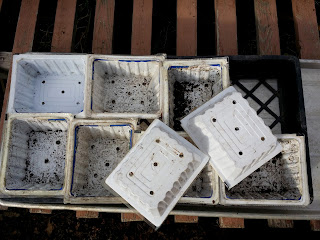Hello friends of the Sharing Gardens - Well, after only a minor set-back from an historic double ice-storm here in the Pacific NW, we're back on track with significant plantings of early spring crops. Here's news of the storm, pictures from the garden and links to relevant posts for this time of year. Enjoy! And happy gardening!
In mid-January, southwest Washington and northwest Oregon were hit with two back to back ice-storms and several days that didn't get above freezing, with night-time lows in the teens. Heavy, steady, freezing rain just became 2" of sheet-ice in our area. Thousands of trees and branches came down, severing power lines all over the region. We were very fortunate in that we personally only lost power long enough to prompt us to try out our new hand-operated coffee grinder (slow but perfectly adequate). We heat exclusively with wood so our house stayed nice and toasty. Thousands of households lost power for days and in some cases for over a week!
 |
| We heat exclusively with wood and insulated the whole 1875 farmhouse when we did renovations in 2014 so we stayed plenty warm. We often cook on it too. |
The wildlife really suffered. We went through over three gallons of birdseed in four days (three times our usual amount) and had to use ski poles to venture out to where we feed them so we didn't slip and fall. Many types of birds that we don't usually see at our feeders showed up including varied thrushes, quail, red winged black birds and more.
People in our area who didn't have crampons or ski-poles made make-shift traction devices by wrapping small-link chains around their boots and attaching them with twist-ties! One friend had to venture across the frozen nightmare several times a day to feed wild mallards and geese that overwinter at her pond. Another friend tried to help the deer by spreading out apples for them but the deer were having a heck of a time moving across the ice. There was no crust to break through and gain traction...just solid ice all the way to the ground.
 |
| Birds during the ice-storm. At one point I counted over 80 before they took flight and I lost count. |
 |
| This view includes a big apple tree in the middle, flanked by hazelnut trees and a lilac on the right. None of our fruit or nut trees were damaged in the storms. |
Thank goodness for our greenhouses! We already had carrots started in two raised beds - which did fine through the cold. We also had also just planted two-dozen potatoes, 6" underground and under a thick cover of dry leaves. These appear to be doing fine. Their greens are just beginning to emerge from the leaves.
Chris had already started several varieties of seeds in tofu-containers. We brought them in the house during the worst of the freeze.
 |
| Seedlings (foreground/left) we brought inside during the worst of the storms and until things were consistently warm enough to return them to the greenhouse. |
All the seeds that we started before the storm have now been transplanted into bigger pots. They're suffering a little bit from lack of sunlight and are a little spindly. Even though temps rose, it's been a very overcast and drizzly/rainy winter (typical for an El Nino season). Starting seeds in January was pushing things a bit for our area but even if this first batch doesn't do so well, the later batches we've started should do fine. Starting seeds early is always a gamble but it's worth it if you have enough seeds to spare. Starting Seedlings Directly in Greenhouse Raised Beds
 |
| Prior to the ice storm, we still managed to host a few volunteer sessions inside the greenhouses. Here, Donn and Chris are hand-digging in bags of compost (harvested from our greenhouse paths - LINK). Chris rebuilt all the GH raised beds this winter with 2x6 lumber (much of which was salvaged). The black, plastic bags on the other beds keep moisture in the soil, keep the soil temperature warmer (for microbial action) and prevent damage from UV rays. These bags will be re-used over and over again. |
 |
| Suzanne, removing greens from carrots harvested from outside beds in January. |
 |
| The beets weren't quite as productive but we still got 17 pounds. They too were very sweet and tender. |
With February upon us, garden tasks will shift to pruning, turning compost piles, repairs and maintenance on buildings and equipment, along with transplanting seedlings and other tasks. If you're local and thinking you'd like to join us for the coming season, here's info about our share-giver (volunteer) program: (LINK: Volunteering and Garden Location ).
Here are timely LINKS for your own early-spring planting:
Valentines Day - Time for Pea Planting!
Sprouting potatoes? What to do.
Can I Speed Up Potato Sprouting?
Do I Need to Buy Seed Potatoes or Can I Just Grow Potatoes from the Grocery Store?
Onions - Growing From Seed - deep pots
Onions - Growing from Seed - Using heat mats and shallow pots
And remember...If you plant it, they will come!




































